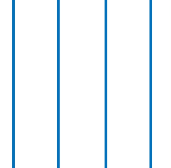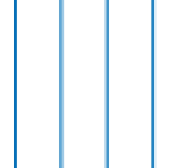Area 属性
区域图的外观和行为
Area 属性控制 Area 对象的外观和行为。通过更改属性值,您可以修改区域图的某些方面。使用圆点表示法查询和设置属性。
ar = area(1:10); ar.EdgeColor = 'red';
颜色和样式
区域填充颜色,指定为 RGB 三元组、十六进制颜色代码、颜色名称或 'flat'。
从 R2017b 开始,默认值是来自坐标区的 ColorOrder 属性的一个 RGB 三元组。在以前的版本中,默认值为 'flat',且颜色基于颜色图。
对于自定义颜色,请指定 RGB 三元组或十六进制颜色代码。
RGB 三元组是包含三个元素的行向量,其元素分别指定颜色中红、绿、蓝分量的强度。强度值必须位于
[0,1]范围内,例如[0.4 0.6 0.7]。十六进制颜色代码是字符串标量或字符向量,以井号 (
#) 开头,后跟三个或六个十六进制数字,范围可以是0到F。这些值不区分大小写。因此,颜色代码"#FF8800"与"#ff8800"、"#F80"与"#f80"是等效的。
此外,还可以按名称指定一些常见的颜色。下表列出了一些命名颜色选项、其等效 RGB 三元组及十六进制颜色代码。
| 颜色名称 | 短名称 | RGB 三元组 | 十六进制颜色代码 | 外观 |
|---|---|---|---|---|
"red" | "r" | [1 0 0] | "#FF0000" |
|
"green" | "g" | [0 1 0] | "#00FF00" |
|
"blue" | "b" | [0 0 1] | "#0000FF" |
|
"cyan" | "c" | [0 1 1] | "#00FFFF" |
|
"magenta" | "m" | [1 0 1] | "#FF00FF" |
|
"yellow" | "y" | [1 1 0] | "#FFFF00" |
|
"black" | "k" | [0 0 0] | "#000000" |
|
"white" | "w" | [1 1 1] | "#FFFFFF" |
|
"none" | 不适用 | 不适用 | 不适用 | 无颜色 |
下表列出了浅色和深色主题中绘图的默认调色板。
| 调色板 | 调色板颜色 |
|---|---|
在 R2025a 之前的版本中: 大多数绘图默认使用这些颜色。 |
|
|
|
您可以使用 orderedcolors 和 rgb2hex 函数获取这些调色板的 RGB 三元组和十六进制颜色代码。例如,获取 "gem" 调色板的 RGB 三元组并将其转换为十六进制颜色代码。
RGB = orderedcolors("gem");
H = rgb2hex(RGB);在 R2023b 之前的版本中: 使用 RGB = get(groot,"FactoryAxesColorOrder") 获取 RGB 三元组。
在 R2024a 之前的版本中: 使用 H = compose("#%02X%02X%02X",round(RGB*255)) 获取十六进制颜色代码。
控制如何设置 FaceColor 属性,指定为下列值之一:
"auto"- MATLAB® 通过使用Area对象的SeriesIndex属性和坐标区的ColorOrder属性来控制FaceColor属性的值。"manual"- 您可以直接设置FaceColor属性的值,或在创建Area对象时将其作为函数参量间接进行设置。
如果您手动更改 FaceColor 属性的值,MATLAB 会将 FaceColorMode 属性的值更改为 "manual"。
区域轮廓颜色,指定为 RGB 三元组、十六进制颜色代码、颜色名称或 'flat'。将此属性指定为 'flat' 将使用颜色图的颜色。
对于自定义颜色,请指定 RGB 三元组或十六进制颜色代码。
RGB 三元组是包含三个元素的行向量,其元素分别指定颜色中红、绿、蓝分量的强度。强度值必须位于
[0,1]范围内,例如[0.4 0.6 0.7]。十六进制颜色代码是字符串标量或字符向量,以井号 (
#) 开头,后跟三个或六个十六进制数字,范围可以是0到F。这些值不区分大小写。因此,颜色代码"#FF8800"与"#ff8800"、"#F80"与"#f80"是等效的。
此外,还可以按名称指定一些常见的颜色。下表列出了一些命名颜色选项、其等效 RGB 三元组及十六进制颜色代码。
| 颜色名称 | 短名称 | RGB 三元组 | 十六进制颜色代码 | 外观 |
|---|---|---|---|---|
"red" | "r" | [1 0 0] | "#FF0000" |
|
"green" | "g" | [0 1 0] | "#00FF00" |
|
"blue" | "b" | [0 0 1] | "#0000FF" |
|
"cyan" | "c" | [0 1 1] | "#00FFFF" |
|
"magenta" | "m" | [1 0 1] | "#FF00FF" |
|
"yellow" | "y" | [1 1 0] | "#FFFF00" |
|
"black" | "k" | [0 0 0] | "#000000" |
|
"white" | "w" | [1 1 1] | "#FFFFFF" |
|
"none" | 不适用 | 不适用 | 不适用 | 无颜色 |
下表列出了浅色和深色主题中绘图的默认调色板。
| 调色板 | 调色板颜色 |
|---|---|
在 R2025a 之前的版本中: 大多数绘图默认使用这些颜色。 |
|
|
|
您可以使用 orderedcolors 和 rgb2hex 函数获取这些调色板的 RGB 三元组和十六进制颜色代码。例如,获取 "gem" 调色板的 RGB 三元组并将其转换为十六进制颜色代码。
RGB = orderedcolors("gem");
H = rgb2hex(RGB);在 R2023b 之前的版本中: 使用 RGB = get(groot,"FactoryAxesColorOrder") 获取 RGB 三元组。
在 R2024a 之前的版本中: 使用 H = compose("#%02X%02X%02X",round(RGB*255)) 获取十六进制颜色代码。
面透明度,指定为 [0,1] 范围中的标量。值为 1 表示不透明,值为 0 表示完全透明。介于 0 和 1 之间的值表示半透明。
示例: a.FaceAlpha = 0.5;
边透明度,指定为 [0,1] 范围内的标量。值为 1 表示不透明,值为 0 表示完全透明。介于 0 和 1 之间的值表示半透明。
示例: a.EdgeAlpha = 0.5;
线型,指定为下表中列出的选项之一。
| 线型 | 描述 | 表示的线条 |
|---|---|---|
"-" | 实线 |
|
"--" | 虚线 |
|
":" | 点线 |
|
"-." | 点划线 |
|
"none" | 无线条 | 无线条 |
区域轮廓宽度,指定为数值标量(以磅为单位)。一磅等于 1/72 英寸。
示例: 1.5
数据类型: single | double | int8 | int16 | int32 | int64 | uint8 | uint16 | uint32 | uint64
序列索引,指定为正整数或 "none"。此属性可用于重新分配 Area 对象的面颜色,使它们与其他对象的颜色匹配。
默认情况下,SeriesIndex 属性的值是一个与其创建顺序对应的数字,从 1 开始。在您调用绘图函数时,MATLAB 会使用该数字计算分配面颜色的索引。索引引用存储在坐标区的 ColorOrder 属性中的数组的行。坐标区中具有相同 SeriesIndex 编号的任何对象都将具有相同的颜色。
SeriesIndex 值 "none" 对应于不参与索引方案的中性颜色。
手动颜色分配如何覆盖 SeriesIndex 行为
要手动控制填充颜色,请将 Area 对象的 FaceColor 属性设置为颜色值,如颜色名称或 RGB 三元组。
当您手动设置对象的填充颜色时,MATLAB 会禁用该对象的自动颜色选择,并允许您的颜色保持不变,而不管 SeriesIndex 属性的值如何。FaceColorMode 属性表示颜色是(由您)手动设置的还是系统自动设置的。值 "manual" 表示手动选择,值 "auto" 表示自动选择。
要再次启用自动选择,请将 SeriesIndex 属性设置为正整数,并将 FaceColorMode 属性设置为 "auto"。
在某些情况下,MATLAB 会将 SeriesIndex 值设置为 0,这也会禁用自动颜色选择。
锐化垂直线和水平线,指定为 'on' 或 'off',或指定为数值或逻辑值 1 (true) 或 0 (false)。值 'on' 等效于 true,'off' 等效于 false。因此,您可以使用此属性的值作为逻辑值。该值存储为 matlab.lang.OnOffSwitchState 类型的 on/off 逻辑值。
| 值 | 描述 | 外观 |
|---|---|---|
'on' | 锐化垂直线和水平线以消除外观不均现象。 |
|
'off' | 不锐化垂直线或水平线。线条可能出现不均匀的厚度或颜色。 |
|
基线
基线值,指定为数值标量。基线值指定水平基线的 y 坐标。区域图填充在数据值和基线之间的区域。
基线可见性,指定为 'on' 或 'off',或者指定为数值或逻辑值 1 (true) 或 0 (false)。值 'on' 等效于 true,'off' 等效于 false。因此,您可以使用此属性的值作为逻辑值。该值存储为 matlab.lang.OnOffSwitchState 类型的 on/off 逻辑值。
'on'- 显示基线。'off'- 隐藏基线。
此 属性 为只读。
基线对象。有关基线属性列表,请参阅 Baseline 属性。
数据
x 坐标,指定为向量。或者,使用 area 函数的输入参量 X 指定 x 坐标。如果您不指定 X,则 area 将使用 YData 中的值的索引作为 x 坐标。
XData 和 YData 的长度必须相同。
示例: 1:10
数据类型: single | double | int8 | int16 | int32 | int64 | uint8 | uint16 | uint32 | uint64 | categorical | datetime | duration
XData 的选择模式,指定为下列值之一:
'auto'- 使用YData中的值的索引。'manual'- 使用手动指定的值。要指定这些值,请设置XData属性或将输入参量X传递给area函数。
链接到 XData 的变量,指定为包含 MATLAB 工作区变量名称的字符向量或字符串。MATLAB 通过计算基础工作区中的变量来生成 XData。
默认情况下,没有链接的变量,因此该值为空字符向量 ''。如果您链接变量,MATLAB 不会立即更新 XData 值。若要强制更新数据值,需要使用 refreshdata 函数。
注意
如果您将一个数据源属性更改为包含不同维度数据的变量,则可能会导致函数生成警告,且在将所有数据源属性更改为适当值之前将无法显示图形。
示例: 'x'
y 坐标,指定为向量。或者,使用 area 函数的输入参量 Y 指定 y 坐标。
XData 和 YData 的长度必须相同。
示例: 1:10
数据类型: single | double | int8 | int16 | int32 | int64 | uint8 | uint16 | uint32 | uint64 | duration
链接到 YData 的变量,指定为包含 MATLAB 工作区变量名称的字符向量或字符串。MATLAB 通过计算基础工作区中的变量来生成 YData。
默认情况下,没有链接的变量,因此该值为空字符向量 ''。如果您链接变量,MATLAB 不会立即更新 YData 值。若要强制更新数据值,需要使用 refreshdata 函数。
注意
如果您将一个数据源属性更改为包含不同维度数据的变量,则可能会导致函数生成警告,且在将所有数据源属性更改为适当值之前将无法显示图形。
示例: 'y'
图例
图例标签,指定为字符向量或字符串标量。只有调用 legend 命令之后,才会显示图例。如果未指定文本,则 legend 使用 'dataN' 形式设置标签。
在图例中包含对象,指定为 Annotation 对象。将 Annotation 对象的基础 IconDisplayStyle 属性设置为以下值之一:
"on"- 在图例中包含对象(默认值)。"off"- 不在图例中包含对象。
例如,要从图例中排除名为 obj 的 Area 对象,请将 IconDisplayStyle 属性设置为 "off"。
obj.Annotation.LegendInformation.IconDisplayStyle = "off";
您也可以使用 legend 函数控制图例中的项目。将第一个输入参量指定为要包含的图形对象的向量。如果未在第一个输入参量中指定现有图形对象,则该图形对象不会显示在图例中。但在创建图例后添加到坐标区的图形对象会显示在图例中。请考虑在创建所有绘图后创建图例以避免出现额外的项。
交互性
可见性状态,指定为 "on" 或 "off",或者指定为数值或逻辑值 1 (true) 或 0 (false)。值 "on" 等效于 true,"off" 等效于 false。因此,您可以使用此属性的值作为逻辑值。该值存储为 matlab.lang.OnOffSwitchState 类型的 on/off 逻辑值。
"on"- 显示对象。"off"- 隐藏对象而不删除它。您仍然可以访问不可见对象的属性。
数据提示内容,指定为 DataTipTemplate 对象。您可以通过修改底层 DataTipTemplate 对象的属性来控制数据提示中显示的内容。有关属性列表,请参阅 DataTipTemplate 属性。
有关修改数据提示的示例,请参阅创建自定义数据提示。
注意
findobj 或 findall 不返回 DataTipTemplate 对象,copyobj 也不复制该对象。
上下文菜单,指定为 ContextMenu 对象。使用此属性在您右键点击对象时显示上下文菜单。使用 uicontextmenu 函数创建上下文菜单。
注意
如果 PickableParts 属性设置为 'none' 或者 HitTest 属性设置为 'off',该上下文菜单将不显示。
选择状态,指定为 'on' 或 'off',或者指定为数值或逻辑值 1 (true) 或 0 (false)。值 'on' 等效于 true,'off' 等效于 false。因此,您可以使用此属性的值作为逻辑值。该值存储为 matlab.lang.OnOffSwitchState 类型的 on/off 逻辑值。
'on'- 已选择。如果您在绘图编辑模式下点击对象,则 MATLAB 会将其Selected属性设置为'on'。如果SelectionHighlight属性也设置为'on',则 MATLAB 将在对象周围显示选择句柄。'off'- 未选择。
选择时显示选择句柄,指定为 'on' 或 'off',或者指定为数值或逻辑值 1 (true) 或 0 (false)。值 'on' 等效于 true,'off' 等效于 false。因此,您可以使用此属性的值作为逻辑值。该值存储为 matlab.lang.OnOffSwitchState 类型的 on/off 逻辑值。
'on'- 在Selected属性设置为'on'时显示选择句柄。'off'- 永远不显示选择句柄,即使Selected属性设置为'on'也是如此。
按照坐标区范围裁剪对象,指定为 'on' 或 'off',或者指定为数值或逻辑值 1 (true) 或 0 (false)。值 'on' 等效于 true,'off' 等效于 false。因此,您可以使用此属性的值作为逻辑值。该值存储为 matlab.lang.OnOffSwitchState 类型的 on/off 逻辑值。
值为
'on'会裁剪对象超出坐标区范围的部分。值为
'off'会显示整个对象,即使对象的某些部分超出坐标区范围。如果您创建一个图、设置hold on、冻结坐标区缩放,然后创建比原始图更大的对象,则该对象的某些部分可能会显示在坐标区范围之外。
必须将包含该对象的坐标区的 Clipping 属性设置为 'on'。否则,此属性不起作用。有关裁剪行为的详细信息,请参阅坐标区的 Clipping 属性。
回调
鼠标点击回调,指定为下列值之一:
函数句柄
元胞数组,包含一个函数句柄和其他参量
作为有效 MATLAB 命令或函数(在基础工作区中计算)的字符向量(不推荐)
使用此属性在您点击对象时执行代码。如果使用函数句柄指定此属性,则 MATLAB 在执行回调时将向回调函数传递两个参量:
点击的对象 - 从回调函数中访问点击的对象的属性。
事件数据 - 空参量。在函数定义中将其替换为波浪号字符 (
~) 以指示不使用此参量。
有关如何使用函数句柄定义回调函数的详细信息,请参阅Create Callbacks for Graphics Objects。
注意
如果 PickableParts 属性设置为 'none' 或者 HitTest 属性设置为 'off',则不执行此回调。
对象创建函数,指定为下列值之一:
函数句柄。
第一个元素是函数句柄的元胞数组。元胞数组中的后续元素是传递到回调函数的参量。
包含有效 MATLAB 表达式的字符向量(不推荐)。MATLAB 在基础工作区计算此表达式。
有关将回调指定为函数句柄、元胞数组或字符向量的详细信息,请参阅Create Callbacks for Graphics Objects。
此属性指定要在 MATLAB 创建对象时执行的回调函数。MATLAB 将在执行 CreateFcn 回调之前初始化所有属性值。如果不指定 CreateFcn 属性,则 MATLAB 执行默认的创建函数。
对现有组件设置 CreateFcn 属性没有任何作用。
如果将此属性指定为函数句柄或元胞数组,则可以使用回调函数的第一个参量访问正在创建的对象。否则,使用 gcbo 函数访问该对象。
对象删除函数,指定为下列值之一:
函数句柄。
第一个元素是函数句柄的元胞数组。元胞数组中的后续元素是传递到回调函数的参量。
包含有效 MATLAB 表达式的字符向量(不推荐)。MATLAB 在基础工作区计算此表达式。
有关将回调指定为函数句柄、元胞数组或字符向量的详细信息,请参阅Create Callbacks for Graphics Objects。
此属性指定在 MATLAB 删除对象时要执行的回调函数。MATLAB 在销毁对象的属性之前执行 DeleteFcn 回调。如果不指定 DeleteFcn 属性,则 MATLAB 执行默认的删除函数。
如果将此属性指定为函数句柄或元胞数组,则可以使用回调函数的第一个参量访问要删除的对象。否则,使用 gcbo 函数访问该对象。
回调执行控件
回调中断,指定为 'on' 或 'off',或者指定为数值或逻辑值 1 (true) 或 0 (false)。值 'on' 等效于 true,'off' 等效于 false。因此,您可以使用此属性的值作为逻辑值。该值存储为 matlab.lang.OnOffSwitchState 类型的 on/off 逻辑值。
此属性确定是否可以中断运行中回调。有以下两种回调状态要考虑:
运行中回调是当前正在执行的回调。
中断回调是试图中断运行中回调的回调。
每次执行处理回调队列的命令时,MATLAB 都会确定回调中断行为。这些命令包括 drawnow、figure、uifigure、getframe、waitfor 和 pause。
如果运行中回调不包含上述命令之一,则不会发生中断。MATLAB 首先完成执行运行中回调,然后执行中断回调。
如果运行中回调确实包含上述命令之一,则由运行中回调所属对象的 Interruptible 属性来确定是否发生中断:
如果
Interruptible的值为'off',则不会发生中断。此时,由中断回调所属对象的BusyAction属性确定中断回调是被丢弃还是添加到回调队列中。如果
Interruptible的值为'on',则发生中断。下次 MATLAB 处理回调队列时,它会停止运行中回调的执行,并执行中断回调。在中断回调完成后,MATLAB 将继续执行运行中回调。
注意
回调的中断和执行在以下情况下会有不同的表现:
如果中断回调是
DeleteFcn、CloseRequestFcn或SizeChangedFcn回调,则无论是否存在Interruptible属性值都会发生中断。如果运行中回调当前正在执行
waitfor函数,则无论是否存在Interruptible属性值都会发生中断。如果中断回调由
Timer对象所有,则回调将根据调度执行,而不考虑Interruptible属性值。
回调排队,指定为 'queue' 或 'cancel'。BusyAction 属性决定 MATLAB 如何处理中断回调的执行。有以下两种回调状态要考虑:
运行中回调是当前正在执行的回调。
中断回调是试图中断运行中回调的回调。
BusyAction 属性仅在同时满足以下两个条件时才确定回调排队行为:
在这些情况下,由中断回调所属对象的 BusyAction 属性确定 MATLAB 如何处理中断回调。以下是 BusyAction 属性的可能值:
'queue'- 将中断回调放入队列中,以便在运行中回调执行完毕后进行处理。'cancel'- 不执行中断回调。
捕获鼠标点击的能力,指定为以下值之一:
'visible'- 仅当对象可见时才捕获鼠标点击。Visible属性必须设置为'on'。HitTest属性决定是Area对象响应点击还是前代响应点击。'none'- 无法捕获鼠标点击。点击Area对象会将点击操作传递给图窗窗口的当前视图中该对象下方的对象。Area对象的HitTest属性没有任何作用。
对捕获的鼠标点击的响应,指定为 'on' 或 'off',或者指定为数值或逻辑值 1 (true) 或 0 (false)。值 'on' 等效于 true,'off' 等效于 false。因此,您可以使用此属性的值作为逻辑值。该值存储为 matlab.lang.OnOffSwitchState 类型的 on/off 逻辑值。
'on'- 触发Area对象的ButtonDownFcn回调。如果您已定义ContextMenu属性,则调用上下文菜单。'off'- 触发满足以下条件之一的Area对象的最近前代的回调:HitTest属性设置为'on'。PickableParts属性设置为允许前代捕获鼠标点击的值。
注意
PickableParts 属性决定 Area 对象是否可以捕获鼠标点击。如果无法捕获,则 HitTest 属性没有任何作用。
此 属性 为只读。
删除状态,以 matlab.lang.OnOffSwitchState 类型的 on/off 逻辑值形式返回。
当 DeleteFcn 回调开始执行时,MATLAB 会将 BeingDeleted 属性设置为 'on'。BeingDeleted 属性将一直保持 'on' 设置状态,直到组件对象不再存在为止。
在查询或修改对象之前,请先检查其 BeingDeleted 属性的值,以确认它不是待删除项。
父级/子级
父级,指定为 Axes、Group 或 Transform 对象。
子级,以空的 GraphicsPlaceholder 数组或 DataTip 对象数组形式返回。使用此属性来查看在图上绘制的数据提示的列表。
不能使用 Children 属性添加或删除子级。要向此列表中添加子级,请将 DataTip 对象的 Parent 属性设置为图对象。
父级的 Children 属性中对象句柄的可见性,指定为下列值之一:
"on"- 对象句柄始终可见。"off"- 对象句柄始终不可见。该选项用于防止另一函数无意中对其进行更改。将HandleVisibility设置为"off"可在执行该函数时暂时隐藏句柄。"callback"- 对象句柄在回调或回调所调用的函数中可见,但在从命令行调用的函数中不可见。此选项阻止通过命令行访问对象,但允许回调函数访问对象。
如果父级的 Children 属性中未列出该对象,则通过搜索对象层次结构或查询句柄属性获取对象句柄的函数无法返回该对象。此类函数的示例包括 get、findobj、gca、gcf、gco、newplot、cla、clf 和 close 函数。
隐藏的对象句柄仍有效。将根 ShowHiddenHandles 属性设置为 "on" 以列出所有对象句柄,而不管其 HandleVisibility 属性设置如何。
标识符
此 属性 为只读。
图形对象的类型,以 'area' 形式返回。使用该属性在绘制层次结构中查找指定类型的所有对象,例如,使用 findobj 搜索该类型。
对象标识符,指定为字符向量或字符串标量。您可以指定唯一的 Tag 值作为对象的标识符。如果需要访问您代码中其他位置的对象,可以使用 findobj 函数基于 Tag 值搜索对象。
用户数据,指定为任何 MATLAB 数组。例如,您可以指定标量、向量、矩阵、元胞数组、字符数组、表或结构体。使用此属性存储对象上的任意数据。
如果您在 App 设计工具中工作,请在该 App 中创建公共或私有属性以共享数据,而不是使用 UserData 属性。有关详细信息,请参阅在用 App 设计工具创建的 App 内共享数据。
版本历史记录
在 R2006a 之前推出通过将 SeriesIndex 属性设置为 "none" 退出 Area 对象的自动颜色选择。当您指定 "none" 时,Area 对象具有中性颜色。
要再次启用自动颜色选择,请将 SeriesIndex 属性设置为一个正整数。
区域图的 BaseValue 属性不再依赖坐标区的范围。当您更改坐标区范围或在坐标区内平移时,属性值保持不变。
通过设置 SeriesIndex 属性来控制 Area 对象的颜色变化。当您要匹配坐标区中不同对象的颜色时,此属性很有用。
不推荐设置或获取 UIContextMenu 属性。请改为使用 ContextMenu 属性,该属性接受相同类型的输入,其行为方式与 UIContextMenu 属性相同。
没有删除 UIContextMenu 属性的计划,但当您对 Area 对象调用 set、get 或 properties 函数时,该属性不再列出。
MATLAB Command
You clicked a link that corresponds to this MATLAB command:
Run the command by entering it in the MATLAB Command Window. Web browsers do not support MATLAB commands.
选择网站
选择网站以获取翻译的可用内容,以及查看当地活动和优惠。根据您的位置,我们建议您选择:。
您也可以从以下列表中选择网站:
如何获得最佳网站性能
选择中国网站(中文或英文)以获得最佳网站性能。其他 MathWorks 国家/地区网站并未针对您所在位置的访问进行优化。
美洲
- América Latina (Español)
- Canada (English)
- United States (English)
欧洲
- Belgium (English)
- Denmark (English)
- Deutschland (Deutsch)
- España (Español)
- Finland (English)
- France (Français)
- Ireland (English)
- Italia (Italiano)
- Luxembourg (English)
- Netherlands (English)
- Norway (English)
- Österreich (Deutsch)
- Portugal (English)
- Sweden (English)
- Switzerland
- United Kingdom (English)















